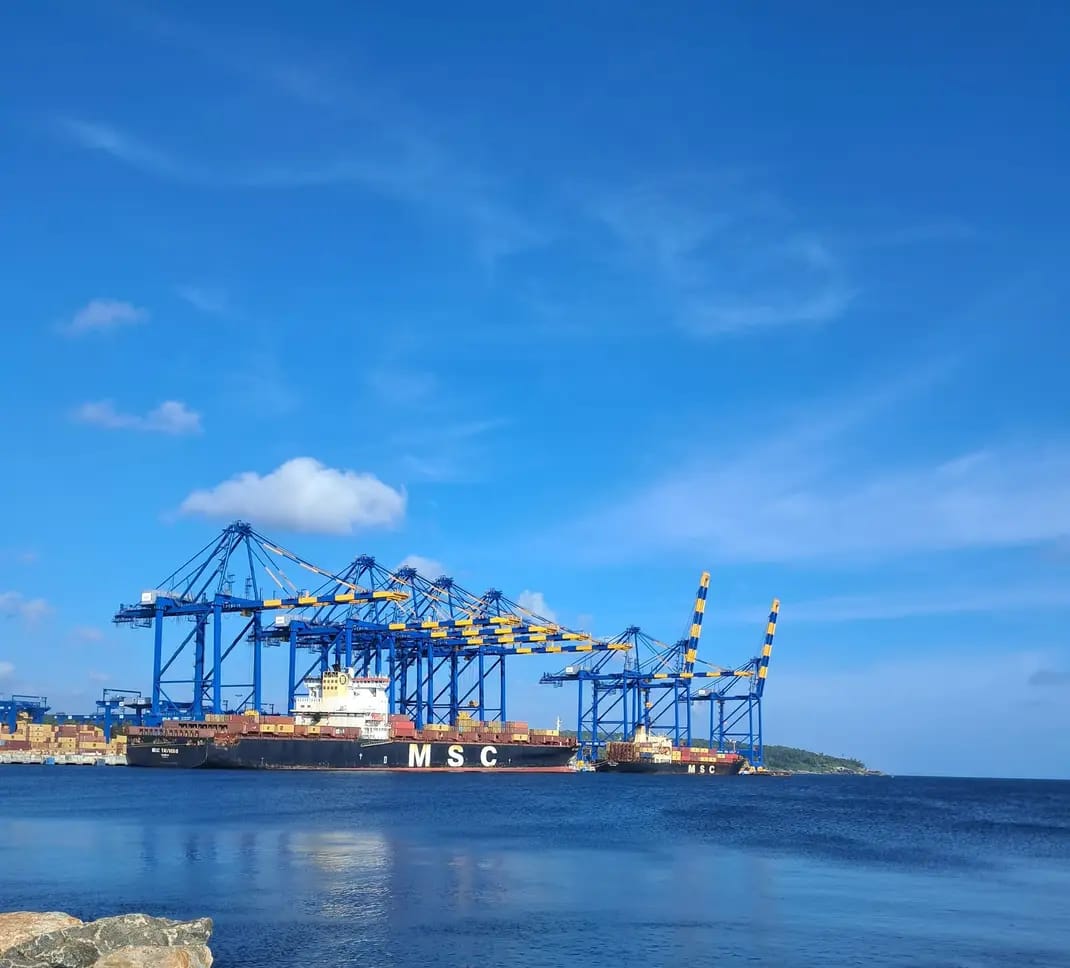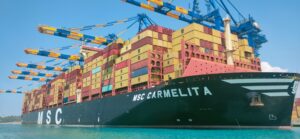Despite multiple reports being submitted by key government agencies on the Vizhinjam International Seaport project, the state government has yet to initiate discussions with stakeholders, raising concerns about transparency and accountability in decision-making.
Published Feb 05, 2025 | 9:00 AM ⚊ Updated Feb 05, 2025 | 12:14 PM

Vizhinjam International Seaport, Thiruvananthapuram.
Synopsis: Kerala’s Vizhinjam port has posted record container traffic with 3 lakh TEUs and 150 ships since operations began in July 2024. Amid this growth, the state government has neither released nor acted upon multiple key reports, including a March 2024 expert committee study on the port’s environmental and socio-economic impacts.
India’s first deep-draft container transshipment hub, the Vizhinjam International Seaport in Thiruvananthapuram, is set to handle 15 per cent of the country’s container transshipment. While the Kerala government views this as a transformative milestone for India’s maritime trade, concerns about its environmental impact remain unaddressed.
An expert committee report examining the port’s impact on coastal erosion and suggesting mitigation measures was submitted to the state government on 6 March 2024. However, the government has neither engaged stakeholders nor released the full report, raising questions about transparency in one of Kerala’s most ambitious infrastructure projects.
The expert committee, constituted on 6 October 2022, began its work on 19 January 2023, following the issuance of Terms of Reference on 7 January 2023.
MD Kudale, former Additional Director of the Central Water and Power Research Station, Pune, led the distinguished panel, which included Dr Riji John, Vice Chancellor, Kerala University of Fisheries and Ocean Studies; Dr Tejal Kanitkar, Associate Professor, School of Natural Sciences and Engineering, National Institute of Advanced Studies, IISc, Bangalore; and Dr PK Chandramohan, Former Chief Engineer, Kandla Port Trust.
The committee was entrusted with evaluating the environmental and socio-economic effects of the seaport project, with a special focus on coastal erosion (assessing its extent post-construction and identifying possible causes, including the role of the seaport), fishing and marine impact (examining how the project influences fishing activities, navigation channels, and the marine ecosystem), mitigation measures (suggesting solutions to minimise any adverse effects) and stakeholder engagement (conducting consultations with affected communities and experts).
The Vizhinjam International Seaport Limited (VISL) provided office space and administrative support, with expenses totalling ₹1,48,286. The committee submitted its interim report on 12 December 2023, followed by the final report in March 2024.
An RTI response on the findings of the committee revealed that the port’s construction has had no significant impact on coastal erosion or fish production. The findings, based on site visits, stakeholder representations and existing study reports, challenge claims linking the port to severe coastal degradation.
The report highlights that Vizhinjam Seaport is situated in a bay flanked by two rocky headlands – Kovalam to the north and Aazhimala to the south – creating a coastal sediment cell with minimal sediment exchange. Notably, the beach south of Aazhimala remains stable, indicating no major sediment movement into the Vizhinjam Bay region.
Further, the committee observed that the fisheries harbour breakwater, built decades ago, has not led to significant sand accumulation or sedimentation issues.
Meanwhile, coastal erosion north of Kovalam Headland – at Valiathura, Cheriyathura, Bheemapalli, and Poonthura – has been ongoing for 30 to 40 years, necessitating seawalls and groynes for protection.
Recent cyclones have worsened erosion in some areas, but the presence of these protective structures has prevented substantial landward recession. However, the committee acknowledged the plight of displaced Valiyathura residents and urged immediate rehabilitation measures.
Many petitioners sought compensation for alleged port-related damages, including demands for housing, land and employment. The committee recommended addressing these grievances appropriately.
On fisheries, studies by the Central Marine Fisheries Research Institute (CMFRI) and the Indian Council of Agricultural Research (ICAR) found no current decline in fish production due to port construction.
However, they stressed the need for continued monitoring during the port’s operational phase. The report also called for urgent repairs and upgrades to damaged seawalls and groynes north of Poonthura to enhance coastal protection.
At the same time, the committee has recommended that the state government set up a dedicated mechanism to address rehabilitation and compensation for affected communities.

MSC Carmelita, one of the largest mother vessels that anchored at Indian ports docked at Vizhinjam Seaport
While the panel stated that the ongoing port construction is not directly responsible for the persistent erosion, it acknowledged the hardships faced by residents in the area.
The committee also emphasised the need to uplift the local fishing community through employment opportunities in port-related sectors and improvements in fishing infrastructure, health and sanitation.
Additionally, the panel called for the revival and upgrading of coastal protection measures along the stretch between Kovalam Headland and Shanghumugham Beach to mitigate further erosion.
Despite multiple reports being submitted by key government agencies on the Vizhinjam International Seaport project, the state government has yet to initiate discussions with stakeholders, raising concerns about transparency and accountability in decision-making.
The state government had earlier sought reports from various departments based on the findings of the Kudale Committee.
The Director of Fisheries was asked to provide a detailed account of fish catch, sales and compensation to fishermen, whilst the Chief Engineer of the Harbour Engineering Department was instructed to submit a report on measures taken to prevent coastal erosion between Kovalam and Shanghumugham.
Additionally, the Managing Director of the Kerala State Coastal Area Development Corporation was asked to furnish details on ongoing and proposed coastal protection works in the region.
The Managing Director of Vizhinjam International Seaport Limited was also directed to report on the compensation granted and welfare measures implemented for those affected by the port’s development.
All these reports have since been submitted. However, in a move that has drawn criticism, the state government has yet to make these reports publicly available.
Adding to the scepticism, there has been no official engagement with the coastal community, despite the findings of the Janakeeya Padana Samithi – a panel appointed by the Latin Archdiocese-led action council in 2022 – raising serious concerns about the project’s environmental and socio-economic impact.
Renowned historian Ramachandra Guha, while releasing the Samithi’s report in November 2023, had described the Vizhinjam port as “economically flawed, socially unjust, environmentally disastrous, and profoundly anti-democratic.”
The report had strongly recommended the implementation of Model Fishing Villages to safeguard the livelihood of the coastal community.
Following this, the Director of Fisheries was asked to review and submit his remarks on these recommendations.
Despite these critical assessments, the Kudale Committee’s findings contradicted the concerns raised, concluding that the port’s construction had no significant impact on coastal erosion or fish production.
Ports Minister VN Vasavan, responding to an Assembly question in July 2024, stated that the government was still examining the committee’s findings.
With no further action taken to address stakeholder concerns or make key reports accessible to the public, questions linger over the government’s intent.
Fisherfolk and environmental activists continue to demand greater transparency and dialogue, urging the authorities to clarify their stance on the Vizhinjam seaport’s long-term consequences.
“We have been kept in the dark even as the port has entered the operational phase. The government has not engaged with us or addressed our concerns,” said Yesudasan, a fisherman from Vizhinjam. “Our livelihoods are at stake, and we deserve to be heard.”
While concerns and doubts linger on one side, the other side shines brightly with Vizhinjam Port scaling new heights. Since the trial run began in July 2024, the port has handled an impressive 3 lakh TEUs, with 150 ships docking at its shores.
January 2025 alone saw a record 45 ships, contributing to a staggering 85,000 TEUs in just one month. Yet, even as the port basks in the limelight of its achievements, the fishing community continues to voice their fears and concerns, urging authorities to address their anxieties amidst this rapid transformation.
(Edited by Dese Gowda)
